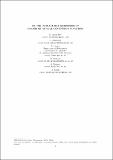Files in this item
On the average box dimensions of graphs of typical continuous functions
Item metadata
| dc.contributor.author | Adam-Day, B. | |
| dc.contributor.author | Ashcroft, C. | |
| dc.contributor.author | Olsen, L. | |
| dc.contributor.author | Pinzani, N. | |
| dc.contributor.author | Rizzoli, A. | |
| dc.contributor.author | Rowe, J. | |
| dc.date.accessioned | 2019-10-02T23:37:30Z | |
| dc.date.available | 2019-10-02T23:37:30Z | |
| dc.date.issued | 2018-12 | |
| dc.identifier | 256346414 | |
| dc.identifier | c7a4ef4a-499c-49ff-8885-765cbbff02a4 | |
| dc.identifier | 85054542052 | |
| dc.identifier | 000449099200001 | |
| dc.identifier.citation | Adam-Day , B , Ashcroft , C , Olsen , L , Pinzani , N , Rizzoli , A & Rowe , J 2018 , ' On the average box dimensions of graphs of typical continuous functions ' , Acta Mathematica Hungarica , vol. 156 , no. 2 , pp. 263-302 . https://doi.org/10.1007/s10474-018-0871-2 | en |
| dc.identifier.issn | 0236-5294 | |
| dc.identifier.other | ORCID: /0000-0002-8353-044X/work/60630678 | |
| dc.identifier.uri | https://hdl.handle.net/10023/18603 | |
| dc.description.abstract | Let X be a bounded subset of Rd and write Cu(X) for the set of uniformly continuous functions on X equipped with the uniform norm. The lower and upper box dimensions, denoted by dim̲B(graph(f)) and dim ¯ B(graph (f)) , of the graph graph (f) of a function f∈ Cu(X) are defined by dim̲B(graph(f))=limδ↘0inflogNδ(graph(f))-logδ,dim¯B(graph(f))=limδ↘0suplogNδ(graph(f))-logδ,where Nδ(graph (f)) denotes the number of δ-mesh cubes that intersect graph (f). Hyde et al. have recently proved that the box counting function(∗)logNδ(graph(f))-logδof the graph of a typical function f∈ Cu(X) diverges in the worst possible way as δ↘ 0. More precisely, Hyde et al. showed that for a typical function f∈ Cu(X) , the lower box dimension of the graph of f is as small as possible and if X has only finitely many isolated points, then the upper box dimension of the graph of f is as big as possible. In this paper we will prove that the box counting function (*) of the graph of a typical function f∈ Cu(X) is spectacularly more irregular than suggested by the result due to Hyde et al. Namely, we show the following surprising result: not only is the box counting function in (*) divergent as δ↘ 0 , but it is so irregular that it remains spectacularly divergent as δ↘ 0 even after being “averaged" or “smoothened out" using exceptionally powerful averaging methods including all higher order Hölder and Cesàro averages and all higher order Riesz–Hardy logarithmic averages. For example, if the box dimension of X exists, then we show that for a typical function f∈ Cu(X) , all the higher order lower Hölder and Cesàro averages of the box counting function (*) are as small as possible, namely, equal to the box dimension of X, and if, in addition, X has only finitely many isolated points, then all the higher order upper Hölder and Cesàro averages of the box counting function (*) are as big as possible, namely, equal to the box dimension of X plus 1. | |
| dc.format.extent | 40 | |
| dc.format.extent | 547544 | |
| dc.language.iso | eng | |
| dc.relation.ispartof | Acta Mathematica Hungarica | en |
| dc.subject | Baire category | en |
| dc.subject | Box dimension | en |
| dc.subject | Cesàro mean | en |
| dc.subject | Continuous functions | en |
| dc.subject | Hölder mean | en |
| dc.subject | Riesz–Hardy mean | en |
| dc.subject | QA Mathematics | en |
| dc.subject | T-NDAS | en |
| dc.subject.lcc | QA | en |
| dc.title | On the average box dimensions of graphs of typical continuous functions | en |
| dc.type | Journal article | en |
| dc.contributor.institution | University of St Andrews. Pure Mathematics | en |
| dc.identifier.doi | 10.1007/s10474-018-0871-2 | |
| dc.description.status | Peer reviewed | en |
| dc.date.embargoedUntil | 2019-10-03 |
This item appears in the following Collection(s)
Items in the St Andrews Research Repository are protected by copyright, with all rights reserved, unless otherwise indicated.

